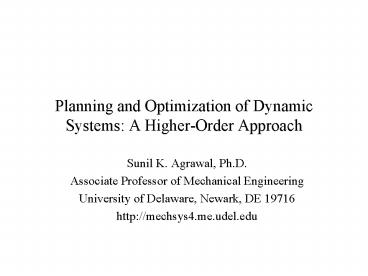Planning and Optimization of Dynamic Systems: A HigherOrder Approach PowerPoint PPT Presentation
Title: Planning and Optimization of Dynamic Systems: A HigherOrder Approach
1
Planning and Optimization of Dynamic Systems A
Higher-Order Approach
- Sunil K. Agrawal, Ph.D.
- Associate Professor of Mechanical Engineering
- University of Delaware, Newark, DE 19716
- http//mechsys4.me.udel.edu
2
Problem Statement
- Develop computationally efficient algorithms for
feasible and/or optimal planning of dynamic
systems. - State equations
- Path and end constraints
- Cost functional
3
Motivation
4
Higher-Order systems
- Canonical transformation of state equations using
linear and nonlinear systems theory
- Controllable linear time-invariant systems
- Classes of time-varying, time-periodic systems
- Feedback linearizable nonlinear systems
- Classes of nonholonomic systems
- Differentially flat systems
5
Outline
- Systems without inequality constraints
- feasible planning admissible forms
- optimal planning variational theory
- Systems with inequality constraints
- feasible planning polytopic approximation
- optimal planning Pontryagin extensions, Mayers
problems, Computation comparisons
6
Higher-Order Systems Examples
7
Higher-Order Systems Examples
8
Feasible Trajectories without Inequalities
9
Optimal Trajectories without InequalitiesFeedback
Linearizable Systems
10
Example Flexible Joint
11
Experiment Free-floating Robot
12
Feasible Planning Inequalities
0
)
,
(
u
x
c
13
Experiment Predator-Prey
c
m
2
y
y
y
x
y
x
1
2
k
k
2
2
T
0
d
y
y
y
C
14
Example PUMA 560
15
Optimal Planning InequalitiesPontryagins
Extensions
16
Higher-Order ToolboxesComputation Comparisons
17
Conclusions Challenges
- Higher-Order approach is computationally
effective for classes of dynamic systems - Extensions to systems with partial higher-order
structures - Handling singularities of transformations
- Extensions to systems that do not admit
higher-order structures
18
Acknowledgments
- Ph.D. students Faiz, Xu, Annapragada,
Veeraklaew, Ferreira - MS students Bhattacharya, Claewplodtook
- Post-docs Visitors Schlemmer, Pfister,
Burkhardt, Murray - NSF, AFOSR, Humboldt Foundation
PowerShow.com is a leading presentation sharing website. It has millions of presentations already uploaded and available with 1,000s more being uploaded by its users every day. Whatever your area of interest, here you’ll be able to find and view presentations you’ll love and possibly download. And, best of all, it is completely free and easy to use.
You might even have a presentation you’d like to share with others. If so, just upload it to PowerShow.com. We’ll convert it to an HTML5 slideshow that includes all the media types you’ve already added: audio, video, music, pictures, animations and transition effects. Then you can share it with your target audience as well as PowerShow.com’s millions of monthly visitors. And, again, it’s all free.
About the Developers
PowerShow.com is brought to you by CrystalGraphics, the award-winning developer and market-leading publisher of rich-media enhancement products for presentations. Our product offerings include millions of PowerPoint templates, diagrams, animated 3D characters and more.

